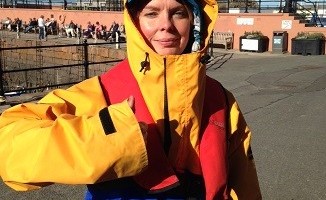Charlotte Bray explains how the Scottish Seabird Centre found a solution to its ancient, inefficient IT system
One of the hardest things for any charity is to find support for core costs.
In an increasingly competitive environment, it is tempting to pursue innovation and project funding, which can seem a more attractive option for funders. Projects have visible results, measurable outcomes and ‘feel-good’ case studies.
In addition, charities’ budgets are becoming tighter and there is a growing demand for public transparency. It can be difficult to find the opportunity to invest in future-proofing.
The final stage is always the nicest: saying thank you. In true Scottish Seabird Centre, we made everyone dress up in bright yellow waterproofs and gave them a boat ride around the islands
Charlotte Bray ready for a Seabird Centre boat trip
At the Scottish Seabird Centre we had a problem.
Like all charities, the Scottish Seabird Centre is hugely reliant on our IT. From finance to fundraising, marketing to membership, it simply wouldn’t be possible to achieve our charitable objectives in wildlife education and conservation without IT support.
Over four years ago we realised there was a pressing need to upgrade. Much of the system had been in place since our launch in 2000. Remember that Microsoft help paperclip? Yup, we still had him.
On a more urgent note, the age of our software and hardware meant Microsoft support was due to be withdrawn. New software packages would not run, our server was in dire straits and failure to complete essential upgrades would leave us exposed to viruses and attack.
To add context, we are at a critical stage in the development of a National Marine Centre. It would be short-sighted to put so much planning and preparation into a major capital build whilst neglecting serious internal support issues. A passage in the Bible cautions against "pouring new wine into old wine skins"; in our case it would be a mistake to have a beautiful new building and facilities without the systems and capacity to use them effectively. A less theological analogy is a stitch in time – not taking the time to address this very real need for change could result in an IT catastrophe of, well, Biblical proportions.
So, the first step to finding a solution was to assess the situation. Any decent problem-solver, or explorer, will first survey the landscape. We gathered some geeks in a room (I’m not sure what the collective noun for geeks is) and they came up with around six options. All them were financially out of reach.
Our next step, therefore, was to look for a funder. We needed a donor with foresight to invest in our future. Here we were extremely fortunate in the William Grant Foundation. The company had given some support in the past, but this was our first major application to its newly formed foundation. In the end, we were one of three grants they awarded specifically focusing on essential infrastructure.
Nothing is ever that simple though. Having gained the funding, there was still the project to deliver. This time it was the Royal Bank of Scotland, in partnership with Fujitsu, who stepped forward. Together with CMYK, our IT helpline, they provided the expertise, advice and in-kind support to make the upgrade possible. The plans thought out by our room of geeks were reviewed, discussed and re-drafted until we had a solution that achieved the right balance: affordable, achievable and sustainable for the future.
There followed some extremely tense weeks while our corporate friends, together with Seabird Centre staff, had to coordinate installation of a new server, hardware and software. There were some sleepless nights as we all anticipated some 2001 Space Odyssey style crash-down at any minute.
All the hard work paid off though and the results are even better than anticipated. It is hard to describe the delight of turning your computer on and actually expecting it to work! The last few weeks have made us realise what we were putting up with.
The final stage is always the nicest: saying thank you. In true Scottish Seabird Centre, we made everyone dress up in bright yellow waterproofs and gave them a boat ride around the islands. The sun shone (not planned, but welcome) and everyone was cheered by the sight of diving gannets and a face-full of sea-spray.
This brings us full circle. In the end, something apparently intangible and invisible, but essential, like an IT upgrade can ultimately help us achieve our mission: to inspire people to learn about and care for our wonderful wildlife and environment.







